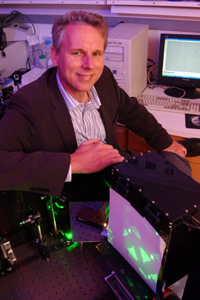Jun 14 2005
 |
| UT Southwestern's Dr. Harold "Skip" Garner and his colleagues have developed the first true, three-dimensional holographic movies. The technology shows promise for medical visualization and heads-up displays for helmets and military aircraft. |
In a small research laboratory at UT Southwestern Medical Center, a grainy, red movie of circling fighter jets emerges from a table-top black box, while nearby, a video of a rotating human heart hangs suspended in a tank of gooey gel.
These images - the first true, three-dimensional, holographic movies - are the brainchild of Dr. Harold "Skip" Garner, professor of biochemistry and internal medicine at UT Southwestern.
While such movies will not be coming soon to a theater near you, they have earned Dr. Garner and his "holographic television" a spot on Popular Science magazine's list of the top five "great ideas for the future," featured in the June 2005 issue.
"I thought it was great that we made this list," Dr. Garner said. "It's good company to be in."
Also on the Popular Science list are a bionic eye, technology for a "smart" home, a tourist's spacesuit and the ultimate roller coaster.
"An important next step is to take our proof of principle technology that we have now and move it into a commercial entity," said Dr. Garner. "We think the two initial markets will be in medical visualization and military applications, such as heads-up displays for helmets and military aircraft and coordinating battlefield information."
In the long term, Dr. Garner said, entertainment uses could include 3-D multiplayer games, theme park or advertising displays, and "Holo TV." He and his colleagues have worked with students in Southern Methodist University's Cox School of Business to develop a tentative business plan that explores the possible commercialization of the technology, focusing on medical applications.
"I predict that by the year 2020, that being the year of 'perfect vision,' we will have Holo TV in our homes," said Dr. Michael Huebschman, a postdoctoral researcher in Dr. Garner's lab and one of the developers of the technology.
Dr. Garner's holographic video system is based on complex optics principles, sophisticated computer programs, and a small computer chip covered with about a million tiny mirrors. He and his research team - Dr. Huebschman and computer programmer Bala Munjuluri - have published details of their system in several publications, including in the journal Optics Express in 2003. Dr. Garner's Web site contains technical details and sample holographic movies, at http://innovation.swmed.edu/research/instrumentation/res_inst_dev3d.html
The heart of the holographic system is the digital light processing micro-mirror chip, made by Texas Instruments and currently used in television, video and movie projectors. Those devices incorporate a computer that processes an incoming digital signal by rapidly - several thousand times a second - changing the angle of each micro-mirror to reflect light from a regular light bulb. The resulting image is a two-dimensional video projected onto a screen.
One of Dr. Garner's innovations was to replace regular light with laser light. Such light is coherent, meaning it is made up of light of all one wavelength, with all light waves traveling "in phase" with one another. Light from a white light bulb comprises many different wavelengths that are out of phase.
Dr. Garner's system also requires a different kind of digital signal than those feeding into today's projection TV sets. His signal is a sequence of two-dimensional interference patterns, called interferograms, which can be generated either from scratch or from data gathered from 3-D imaging applications, such as sonograms, CAT scans, magnetic resonance imaging, radar, sonar or computer-aided drafting.
"This technology is potentially powerful for medical applications," Dr. Garner said. "We could easily take data from existing 3-D imaging technologies and feed that into our computer algorithms to generate two-dimensional interferograms."
On a computer screen, interferograms look like tiny random black dots similar to an off-the-air TV channel's "snow." But the patterns, when fed into the digital light processing micro-mirror chip, cause the tiny mirrors to change in a way that, when laser light is reflected off them, projects a 3-D moving image that appears suspended in air, in a special material called agarose gel, or on a stack of liquid crystal plates similar to computer screens.
"Holographic visualization of organs, for example, would improve diagnosis of ailments such as a swollen, damaged or malformed heart," Dr. Garner said. Other possible medical applications include visualization aids for training surgeons, measuring teeth and bone development, and viewing the possible results of plastic surgery before it's actually done.
Dr. Garner's laboratory focuses on building new platform technologies and new techniques that are then applied collaboratively with a variety of experts on campus in many different fields, including aiding studies of cancer, heart disease, infectious diseases and dermatology.